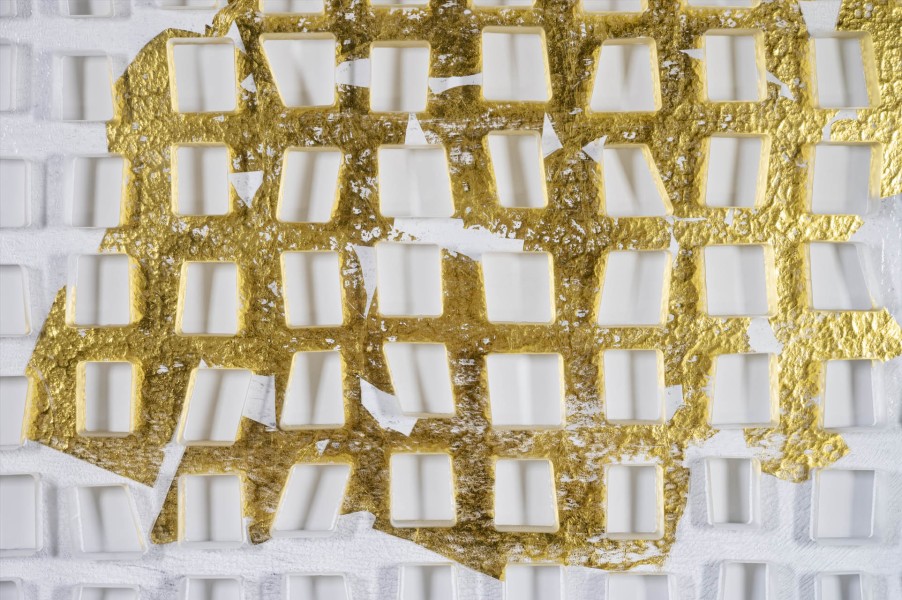Vera Molnár – Icône 2020

Evento collaterale della Biennale di Venezia.
Comunicato stampa
Vera Molnár: Icône 2020 is an exhibition centred on a new commission, Icône 2020, founded, produced and curated by Francesca Franco. This is Vera Molnár’s first ever glass sculpture in a career that spans over 80 years. Taking the new commission as a centre point, this exhibition explores the process that made this sculpture possible, bringing together preparatory sketches, original plotter drawings and documentation material that reveal the complexities behind the making of Icône 2020, encouraging new thinking about sculpture and the unimaginable ramifications of computational art.
Starting from Molnár first successful computer-based artwork created in 1975 (Computer-Icône/2), which in turn originated from a series of computer plotter drawings made in 1974 (Trapèzes), Icône 2020 takes for the first time one of Molnár’s key original concepts based on the dichotomy, and subsequent search for balance, between order and disorder, to three dimensions as a sculpture.
Icône 2020 is a sculpture originated from a unique and unprecedented collaboration created by curator and art historian Francesca Franco, between Hungarian-born artist Vera Molnár (b.1924), pioneer of computer art based in Paris, and a traditional Venetian glassmaker team, whose members are descendants of one of the historic families of Murano where the ancient technique of glassmaking originated in 1291. This collaboration, initiated by Franco in 2019, creates a link that connects for the first time the history of computer art with the ancient tradition of glassmaking with the aim of taking both arts to new unexplored levels.
Under the patronage of Accademia d’Ungheria in Roma, and organised by Atelier Muranese with the support of Arts and Humanities Research Council UK, Henry Moore Foundation, and Leonardo/ISAST/OLATS, Vera Molnár: Icône 2020 features a series of original artworks by Vera Molnár that look at the evolution of her original concept “order/disorder” and how this has materialised over the decades in her production, from the late 1960s up to the present time with this new collaboration, presented for the first time at the Collateral Event of the Biennale Arte 2022.
About the Artist
Vera Molnár, born 1924 in Hungary, is one of the pioneers of computer and algorithmic arts. Trained as a traditional artist, Molnár studied for a diploma in art history and aesthetics at the Budapest College of Fine Arts. She iterated combinatorial images from as early as 1959. In 1968 she began working with computers, where she began to create algorithmic paintings based on simple geometric shapes geometrical themes.
Molnár created her first non-representational images in 1946. These where abstract, geometrically and systematically determined paintings. In 1947 she received an artists’ fellowship to study in Rome at the Villa Giulia, and shortly after moved to France, where she currently resides. In the late 1960s she gained access to a computer at a research lab in Paris and began learning programming languages such as Fortran and Basic. At that time she co-founded several artist research groups: GRAV, who investigate collaborative approaches to mechanical and kinetic art, and Art et Informatique, with a focus on art and computing. In 1968 she started to create computer-based plotter drawings and algorithmic paintings based on simple geometrical themes. Since the 1990s, her work has been featured in major international solo and group exhibitions and is in the collections of the Museum of Modern Art (MoMA NYC), the Victoria&Albert Museum and the Centre Pompidou. In 2005 she was the recipient of the first lifetime achievement award “d.velop digital art award [ddaa]”. In 2018 she won the AWARE Outstanding Merit Award (AWARE Prix d'Honneur), an award supported by the French Ministry of Culture that acknowledges leading female figures in the world of culture.
About the Curator
Francesca Franco is a Venetian-born curator, producer, and art historian based in the UK. She is Senior Research Fellow at the University of Exeter, where she is researching the history of media art. She is Co-Investigator on the AHRC-funded project "Documenting digital art: re-thinking histories and practices of documentation in the museum and beyond". Francesca is Visiting Professor at Danube University Krems, where she teaches Media Art and Curatorial Practice. In 2017, she was curator-in-residence at the Fondazione Bevilacqua La Masa Venice, where she curated Algorithmic Signs, an exhibition that explored the history of pioneering generative art. The central theme of Francesca’s research is the history of art and technology and the pioneers of computer art. A major focus has been the history of the Venice Biennale culminating in a series of publications that have been translated into various languages. Her first solo-authored book, Generative Systems Art, was published by Routledge in 2018. Her second monograph, The Algorithmic Dimension, will be published by Springer in 2022.
Exhibition details:
Title of the Collateral Event: Vera Molnár: Icône 2020.
Venue: New Murano Gallery, Atelier Muranese area, Calle Alvise Vivarini 6, 30141 Murano, Venice
Opening Period: 23 Aprile - 27 Novembre 2022 Opening Times: Every day from 10am to 4pm
Preview dates: 20, 21 and 22 April 2022
Name of the organizing non-profit Institution: Accademia d'Ungheria in Roma
Website of the organizing non-profit Institution: https://culture.hu/it/roma
Website of the Event: www.ateliermuranese.com/icone2020
Name of artist: Vera Molnár
Name and qualifications of curator: Dr Francesca Franco - curator, producer and art historian.
Names of the Sponsors: Arts and Humanities Research Council UK, Henry Moore Foundation, Leonardo/ISAST/OLATS.
For more information, please contact: Press and Communication Office
Tel. +39 0415274633 / +39 0415275088
[email protected] or email Francesca Franco at [email protected] | www.instagram.com/justfrafra | www.francescafranco.net



